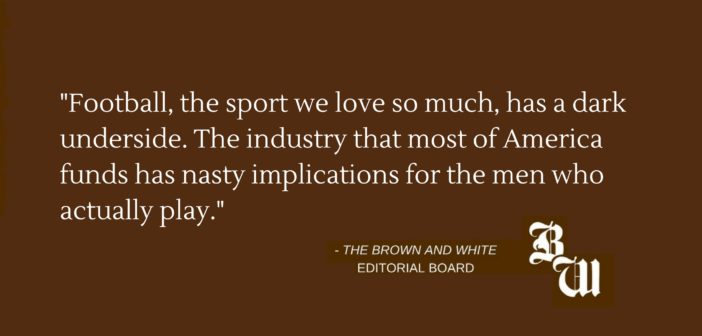The smell of hot dogs, burgers and beer wafts through the air. The stadium erupts with thousands of fans chanting and cheering as they support their favorite teams.
Families and friends sit with one another decked out in team apparel, sharing high fives and smiles when they watch their team score a touchdown.
Whether you’re at a stadium, in the comforts of your own home or at a sports bar, people from all backgrounds will gather together to watch America’s favorite game, football.
In 2016, the NFL made $13 billion in revenue — $3.5 billion more than any other global sports league. This largely stems from fees that television networks pay the NFL. But revenue drivers include local factors as well, such as ticket costs, local sponsorship sales and merchandise.
What could the NFL’s stakeholders have to complain about as a top money-making industry in America?
Well, how about the fact that football players are at a high risk of developing Chronic Traumatic Encephalopathy?
CTE is a degenerative brain disease that is found in people who have experienced constant and repetitive brain trauma. Symptoms resulting from this disease include memory loss, confusion, dementia and depression.
CTE can only be diagnosed after death, and at that point, there is obviously nothing doctors can do.
Studies show that approximately 90 percent of tested brains from former football players had CTE.
NFL athletes are highly profitable, so why aren’t efforts being made to actually protect players from their brains’ inevitable destruction?
It is important to note that this trauma doesn’t only happen to professional athletes. Anyone who is hit enough during this contact sport is at a high risk of being affected by CTE — including college players.
It seems as though the research and protection of professional players’ health is not a priority for the NFL. As a result, college players, who are recruited for the sole purpose of driving their team to victory, are affected as well.
The concept of the trickle-down system applies here. The NFL doesn’t prioritize the safety of their players when it comes to CTE, so the NCAA doesn’t either.
Most college players who are good enough to play for a top college football team intend to continue to the NFL. Even during their time as undergraduate students, college players are often treated like professional players.
Universities use their football players to generate revenue.
These students devote all of their time and energy to becoming the best players possible, which might mean neglecting the educational aspect of college.
This might mean neglecting their safety and health.
College coaches and administrations even encourage student players to prioritize going hard in practices and winning games over discovering passions beyond football.
Why are teenagers given the opportunity to attend premier institutions and not even have a true opportunity to learn and study?
We, as football fans, put pressure on football players whether we know it or not. It is a vicious cycle.
It is hard to stop watching football. And because consumers fund the NFL, regardless of immoral practices, the NFL has no reason to discontinue its behavior. So, if the NFL ignores CTE as an issue, why would colleges fix their practices?
Football, the sport we love so much, has a dark underside. The industry that most of America funds has nasty implications for the men who actually play.
Keep in mind that athletes aren’t invincible.






Comment policy
Comments posted to The Brown and White website are reviewed by a moderator before being approved. Incendiary speech or harassing language, including comments targeted at individuals, may be deemed unacceptable and not published. Spam and other soliciting will also be declined.
The Brown and White also reserves the right to not publish entirely anonymous comments.
2 Comments
http://riskandinsurance.com/uneven-playing-field/
my father played for Cornell’s 1939 unbeaten team. He had the Street & Smith Magazine for that year. the cover story was ‘professionalism in college football.’
We could talk about the racial composition of the teams, too.
What was the name of the story? “Battle Royale”? That one’s from the 1960s, isn’t it. Long enough ago for one, two, three, four generations of young white people to come across it and discover the same old thing as news. But on the betting goes anyhow, with the same kind of people putting up the players and the same drunk fools in the stands over and over again.